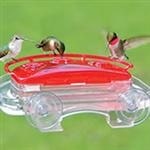Hummingbird Facts and History
Author: Johann Erickson
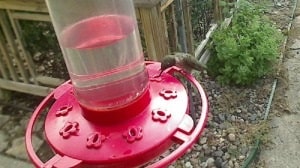
Hummingbird Facts and History
The following provides a few hummingbird facts and a bit of the history of hummingbirds. Sure to interest those who enjoy watching and feeding these tiny jewels of the garden.
The oldest historical mention of hummingbirds dates back to the Taino Native Americans, around the time of Columbus.
The Taino believe that hummingbirds are the spreaders of life on Earth, and their warriors were known as Colibir, or Hummingbird warriors,
because they are a peaceful bird that will defend their territory with the heart of an eagle.
How long they have been in America is unknown, but they have delighted bird watchers for many years, with their quick dashes into the garden, and the shine of the sun on brilliant feathers.
While there actually are duller colored birds, the ruby-throated hummingbirdis the most commonly recognized for its iridescent feathering, and dazzling ruby-red throat.
The color though, is not all it seems.
Hummingbirds get their unusual coloring from the fact that not all feathers are pigmented, or colored. In the duller colors, including the Rufous Hummingbird, the brown hue is actual pigment in the feather structure.
The oldest historical mention of hummingbirds dates back to the Taino Native Americans, around the time of Columbus.
The Taino believe that hummingbirds are the spreaders of life on Earth, and their warriors were known as Colibir, or Hummingbird warriors,
because they are a peaceful bird that will defend their territory with the heart of an eagle.
How long they have been in America is unknown, but they have delighted bird watchers for many years, with their quick dashes into the garden, and the shine of the sun on brilliant feathers.
While there actually are duller colored birds, the ruby-throated hummingbirdis the most commonly recognized for its iridescent feathering, and dazzlig ruby-red throat.
The color though, is not all it seems.
Hummingbirds get their unusual coloring from the fact that not all feathers are pigmented, or colored. In the duller colors, including the Rufous Hummingbird, the brown hue is actual pigment in the feather structure.
In the ruby-throated species, light refracting through the feather segments, breaking it up much like a prism would. Only certain levels of color will be seen by the human eye, and that color will change with every movement of the feather, or angle of the light striking it.
This is one of the features that makes them so charming to watch as they flit around a garden or feeder.
Hummingbirds are very fast, traveling at an average 25 miles per hour, with wingbeats of anywhere from 10-15 per second in the Giant Hummingbird, up to 80 per second by the Amethyst Woodstar. The ruby-throated hummer falls into the middle range, at about 53 beats per second.
To sustain such rapid and prolonged activity, the hummingbird's heart must beat accordingly. For birds that are hot, or sleepy, that can be as low as 50-180 beats per minute, but a heart rate of an amazing 1360 beat per minute has been recorded in a Blue-Throated Hummingbird.
All this activity requires a humming bird to eat almost continually, to fuel the activity that will maintain its 105-109F body heat. That means dining as many as 15 times an hour, on high-energy food.
In volume, they consume up to eight times their body weight a day. But reduce the nectar to a solid by eliminating the water, and it would amount to their own bodyweight.
A hummingbird can starve to death in as little as two hours, if still active. That makes rescue of birds trapped in garages or other enclosed areas, imperative within a short time.
At night, their "thermal generators" shut down as they rest, and allow their body temperature to drop, so that less energy is used up while they sleep.
If you enjoy watching these delightful little birds, and are also an enthusiastic gardener, why not plant clumps of flowers or bushes, to bring them into your yard?
Hummingbirds are creatures of habit, and will develop their own paths to food, checking them frequently and on a daily basis.
Once they find out you have goodies, they'll return over and over. Other hummers will follow, and you may then get to see hummingbird behavior at its worst, as they dive at each other to protect their food sources.
Good choices of food producing plants for hummingbirds include such trees or bushes as Azaleas, Mimosa, Weigela, Cape Honeysuckle and Flowering Quince. Another semi-permanent attraction is a perennial bed with Bee Balm, Columbine, Lupine, Coral Bells and Canna.
You can also plant a wide range of annuals like Fuschia, Impatiens, Petunias and Firespike, but consider growing some of your own plants from seed, as many flowers that are nursery grown, tend not to have as much nectar.
Hummers will be overjoyed to discover this bonanza of blooms, and the tiny bugs that constitute the protein source of their diet.
To make sure you enjoy these little feathered friends for the whole season, hang some hummingbird feeders around your patio or gardens.
But make sure there is a bit of distance between them, to avoid the squabbles, which can be quite a sight!
Because hummers are attracted to red flowers, you'll find many of the hummingbird feeders available, are also colored red.
This isn't an absolute necessity, but it can be a bright spot in your garden. And the feeders come in all kinds of charming shapes from a hanging bunch of grapes, to a giant strawberry.
Commercial powdered "food" formula is available, but you can easily make your own by combining one part sugar to four parts water, and boiling it for two minutes, then cooling and storing in the fridge.
Never use honey, which can ferment, or red dye, which can be harmful to the birds.
Only fill your hummingbird feeders to the one-third or halfway mark, as it would take many birds to empty the contents, and the feeders will need cleaning every few days to prevent the occurrence of mold.
Wash in mild dish detergent, with no more than 10% bleach, and rinse several times. If you have mold inside the feeder and can't reach it with a bottle brush, put some sand in with the water, and swish that back and forth, until the mold is rubbed off.
Hummingbird Trivia Facts
- The hummingbird is so small, that an insect, the Praying Mantis is its natural enemy.
- They are the only bird that can hover, and fly backwards as well as straight up or down
- Hummingbirds can't walk
- The average life of a hummingbird is 3-4 years, although one specimen was caught in 1976 in Colorado, banded, and captured again in 1987
Migration Fact
Often the question is asked, "do hummingbirds ride on the backs of geese during migration?" While this may sound like a reasonable solution, it is not true.
Hummingbirds that migrate, do so on their own wing power.
When Do Hummingbirds Leave For Winter
Leaving your feeders up as long as they are still coming will help them fuel up before their 600 mile journey across the Gulf of Mexico.
A hard date isn't possible since there are several factors that determine migration timing. Ruby-throated hummingbirds are usually what people are asking about.
The best advice I can give is to leave feeders up an additional two weeks past the last time you saw any feeding. Usually sometime in October. But don't hold me to that.
More
The How To's Of Attracting Hummingbirds
Information On Migration and Hummingbirds
Know The Ruby-throated Hummingbird Habits
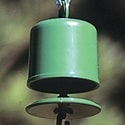 Ant Guard |
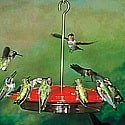 Aspects HummZinger |
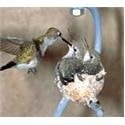 Hummingbird House |
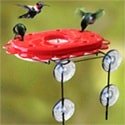 Window Mount |
